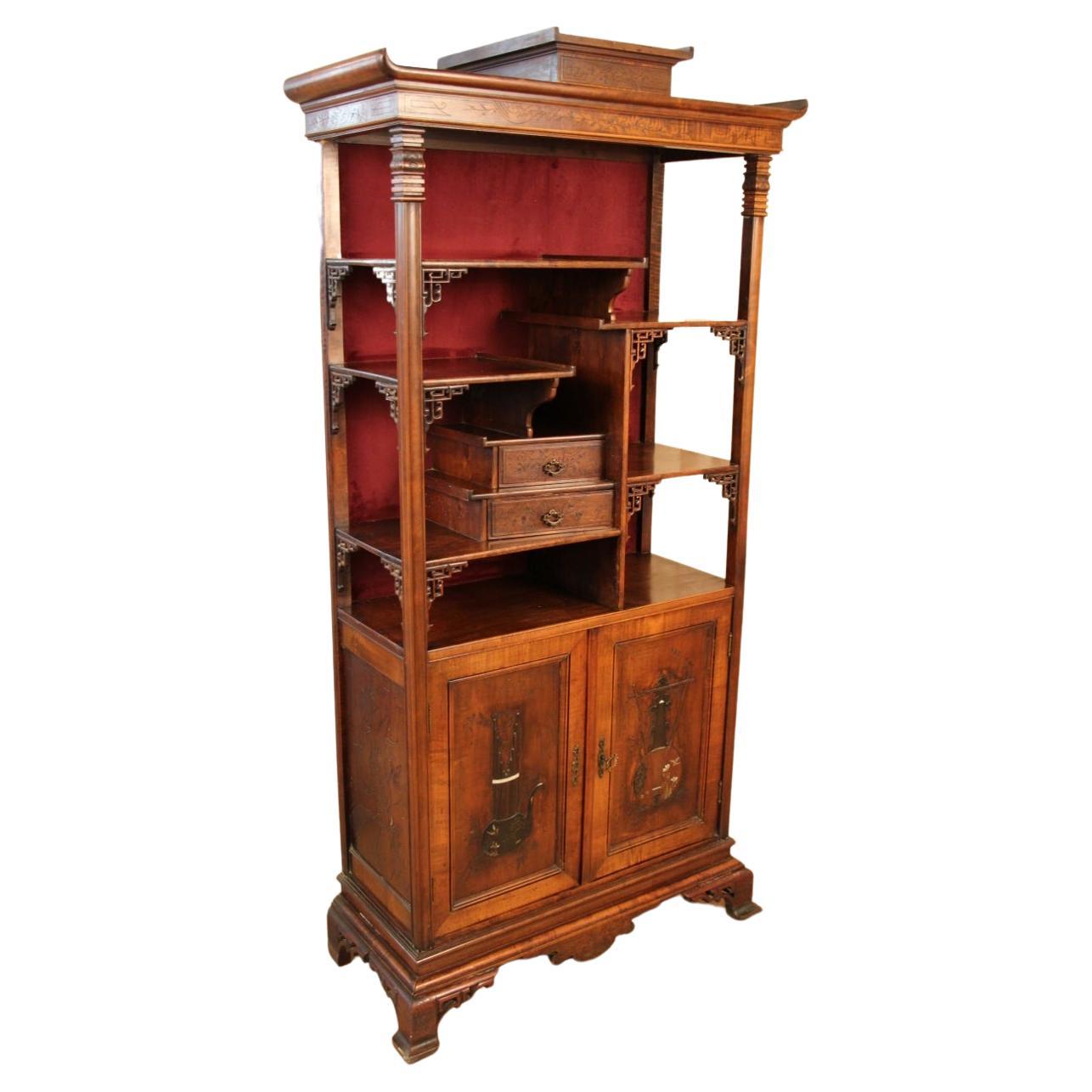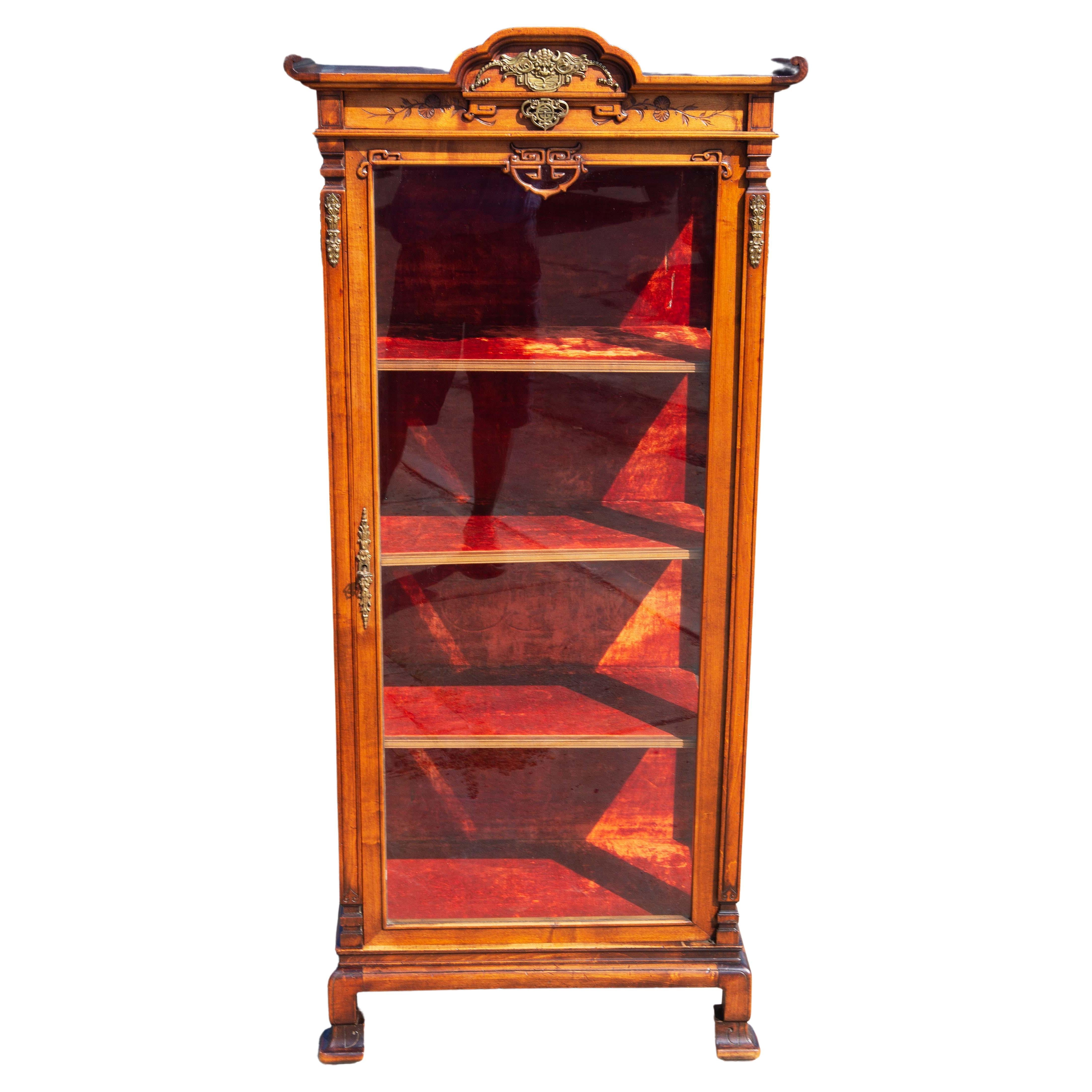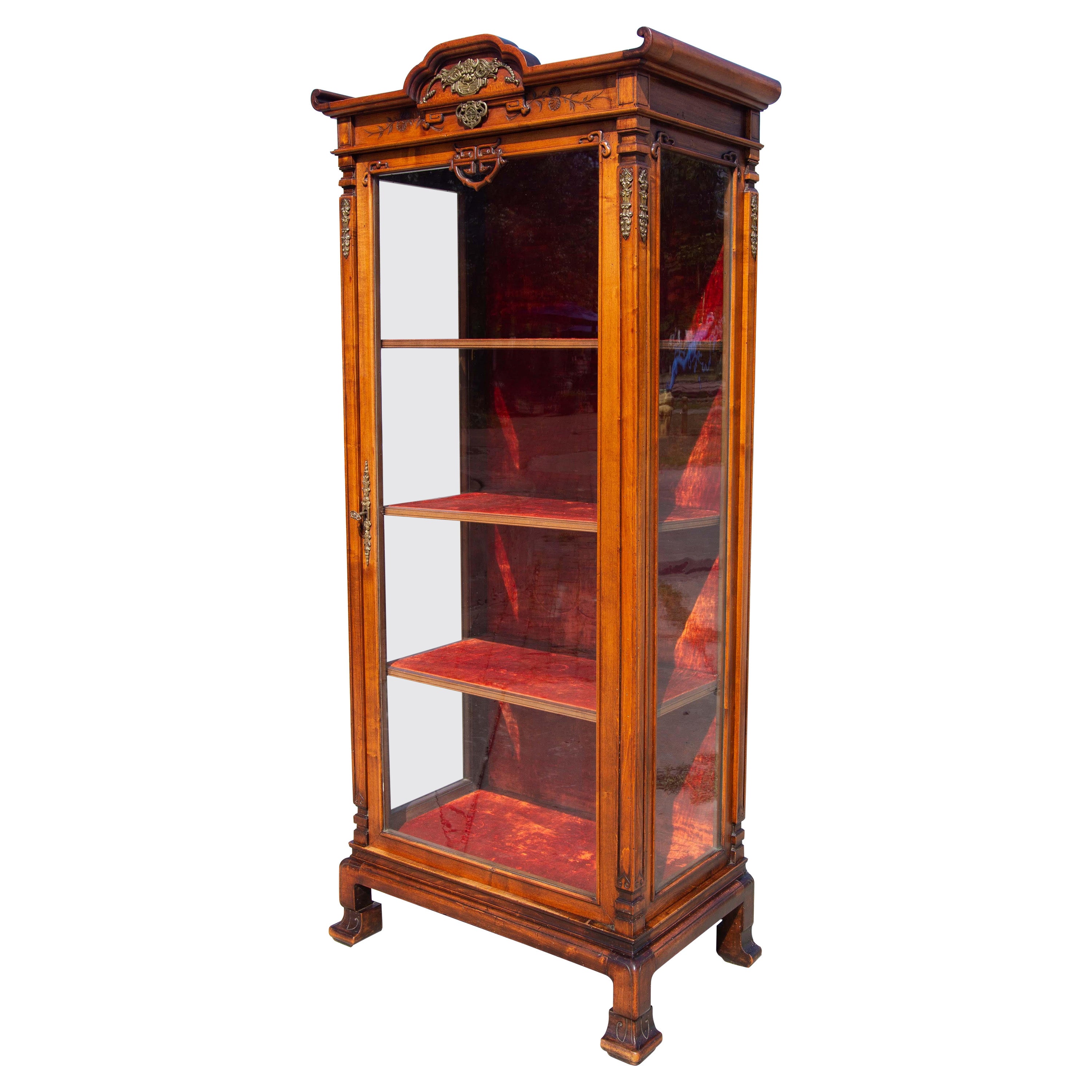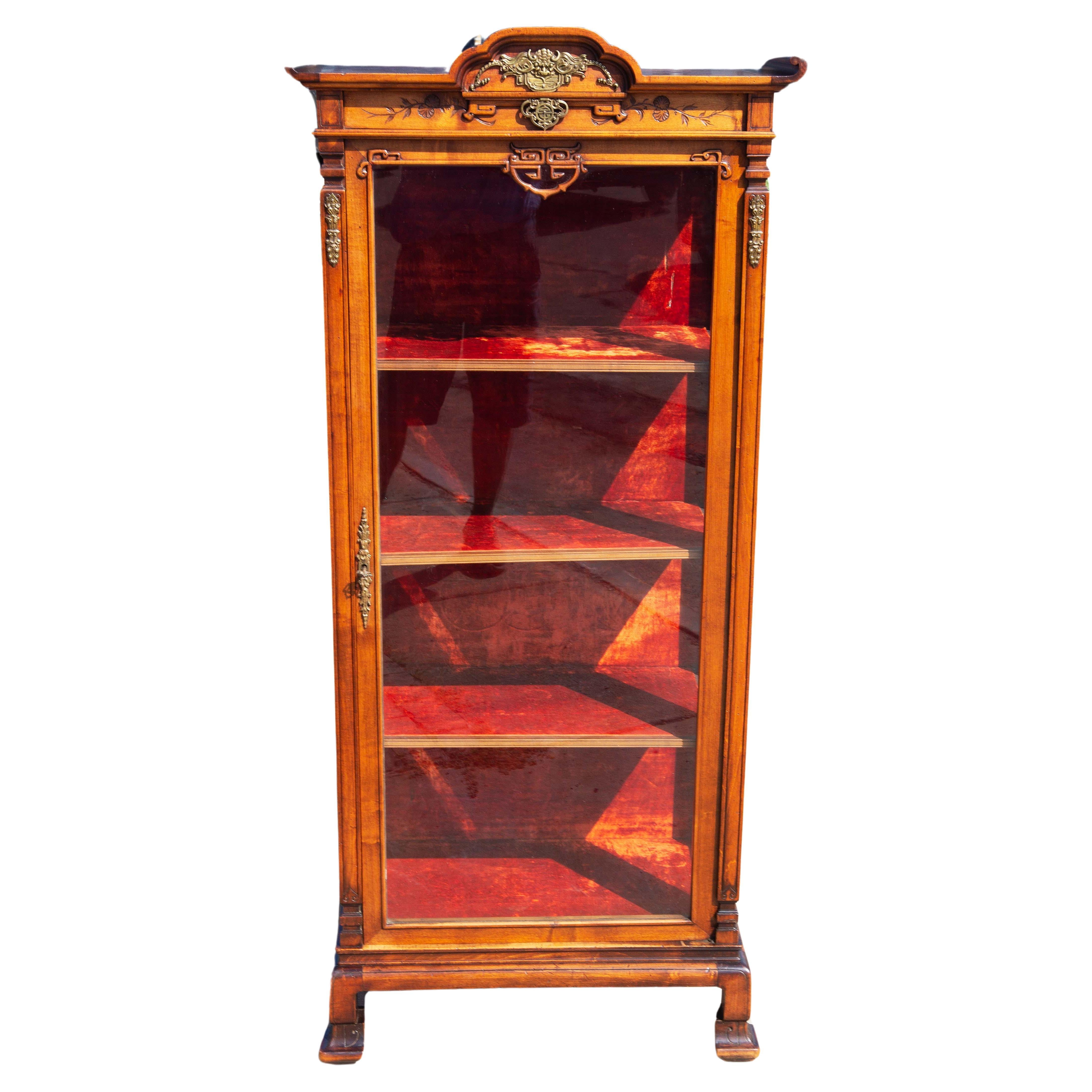Items Similar to Japanese Style Cabinet-Secretary Attributed to G. Viardot, France, Circa 1880
Want more images or videos?
Request additional images or videos from the seller
1 of 13
Japanese Style Cabinet-Secretary Attributed to G. Viardot, France, Circa 1880
About the Item
A Japanese style carved wood cabinet attributed to G. Viardot. A painted decor imitating Japanese lacquer, ornamented with flowers, birds and butterflies. Opening onto two drawers and a paper filer, the upright-secretary door is also fitted with red velvet. Surmounted by a drawer and asymmetrical shelves, composed in the Japanese 'zen' spirit, the cabinet stands on four legs joined by a engraved stretcher.
The great influence of the Far-East, through China and Japan, in the second half of the 19th century French art could be found first in painting and soon after in decorative arts and furniture as well.
Following the Franco-English military Campaign led in 1860 against the Imperial army in China, the French troops of Napoleon III brought back from the Summer Palace, a part of the Chinese Imperial court treasure, which will make up the famous Chinese Museum of Empress Eugénie at the Fontainebleau Palace. The French artists won’t be long to take inspiration from those exotic and sumptuous objects for their creations, as they used to do in the 18th century, when the best French cabinet-makers adapted the Chinese lacquers on the luxurious royal chests.
But the influence of Japan, at the Meiji period (1868-1912), came also very quickly to France, thanks to the opening of the country in the middle of the 19th century, as well as the development of traveling and the amazing Universal Exhibitions, in which Japan participated for the first time in 1867 in Paris. Then many Japanese objects and prints were imported to France and to all Europe, and for which some collectors spent already fortunes.
With Manet and Impressionists generation, the passion for Japanese art, more than a simple taste for an exotic style, was still in fashion until the turn of the 19th century. It provoked not only a craze among the French aristocratic families as well as the wealthy Paris High Society, wishing renew their mansion inner decoration, but turned also to a real revolutionary movement among the “avant-garde” artists. Those artists, whoever they were, painters, cabinet-makers or designers of ceramic, bronze and crystal objects, adapted then those techniques and naturalistic motifs unknown until this time.
- Attributed to:Gabriel Viardot (Cabinetmaker)
- Dimensions:Height: 65.75 in (167 cm)Width: 25.6 in (65 cm)Depth: 12.6 in (32 cm)
- Style:Japonisme (In the Style Of)
- Materials and Techniques:
- Place of Origin:
- Period:
- Date of Manufacture:circa 1880
- Condition:Wear consistent with age and use.
- Seller Location:PARIS, FR
- Reference Number:1stDibs: LU3860313043212
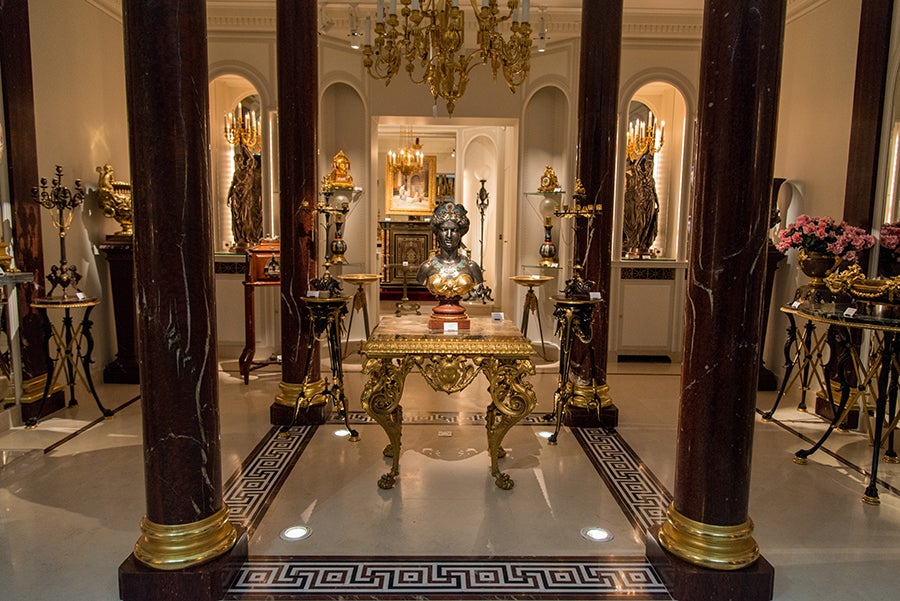
About the Seller
4.9
Vetted Seller
These experienced sellers undergo a comprehensive evaluation by our team of in-house experts.
Established in 1997
1stDibs seller since 2018
73 sales on 1stDibs
Typical response time: <1 hour
Associations
International Confederation of Art and Antique Dealers' Associations
- ShippingRetrieving quote...Ships From: PARIS, France
- Return PolicyA return for this item may be initiated within 7 days of delivery.
More From This SellerView All
- "Pagoda" table, Attributed to G. Viardot, France, Circa 1880By Gabriel ViardotLocated in PARIS, FRCharming Japanese-inspired « pagoda » table in tinted and carved wood attributed to G. Viardot. The rectangular top rests on four slightly curved legs adorned with openwork and sculpted geometric interlacing, joined by an engraved stretcher with a stylized cutout. Gabriel Viardot career began as a wood carver and he produced small furniture, sculpturally carved with naturalistic motifs and animals. In the 1855 Universal Exhibition in Paris, his finely sculpted objects were well received. However, with the increasing importation of similarly produced Swiss and German articles, he found less opportunity for these and decided to innovate. G. Viardot succeeded to his father's business in 1861 installed rue Rambuteau in Paris. Around 1870 he turned to the idea of producing « Meubles genre Chinois et Japonais ». The taste in Europe for exotic furniture, incorporating sometimes authentic Chinese or Japanese objects...Category
Antique 1880s French Japonisme Tables
MaterialsWood
- Pair of "Pagoda" Tables, Attributed to G. Viardot, France, circa 1880By Gabriel ViardotLocated in PARIS, FRHeight : 89 cm (35 in.) ; Length : 72 cm (28,3 in.) ; Width : 42 cm (16,5 in.) Beautiful pair of Japanese-inspired « pagoda » tables in tinted and carved alder. A gilded bronze drag...Category
Antique 1880s French Japonisme Tables
MaterialsBronze
- Rare Aesthetic Movement Wall-Light Attributed to G. Viardot, France, Circa 1880By Gabriel ViardotLocated in PARIS, FRA large Japanese style four lights sconce attributed to G. Viardot, in shape of a dragon made in carved tinted wood, holding in its mouth a Japanese blossoming cherry tree branch, fr...Category
Antique 1880s French Japonisme Wall Lights and Sconces
MaterialsWood
- Aesthetic Movement Jardiniere Attributed to G .Viardot, France, circa 1880By Gabriel ViardotLocated in PARIS, FRA large Japanese style boat-shaped jardiniere attributed to G. Viardot, made in carved wood, ornated with panels decorated with Japanese blossoming cherry tree branches and a trophy ...Category
Antique 1880s French Aesthetic Movement Planters, Cachepots and Jardinières
MaterialsWood
- "Japonisme" Cylinder Desk Att. to G. Viardot, France, circa 1880By Gabriel ViardotLocated in PARIS, FRRare Japanese style cylinder desk in tinted and carved wood, richly engraved on all sides with foliage, cherry branches and geometric interlacing. Surmounted by two asymmetrical shelves, the cylinder is decorated with an engraved dragon. Opening this cylinder reveals many compartments with adjustable dimensions, a drawer with engraved decoration and letter storage. The cylinder sides can open laterally, allowing a larger area for working and writing. The lower part of the desk is formed on the left by five superimposed drawers decorated with geometric interlacing and carved branches, as well as Japanese characters, deer and mother-of-pearl foliage. On the right, there is a drawer and a door decorated with carved leaves and mother-of-pearl interlacing, revealing four drawers forming compartments. An ingenious mechanism makes it possible, when the cylinder is closed with a key, to completely lock the desk. Gabriel Viardot career began as a wood carver and he produced small furniture, sculpturally carved with naturalistic motifs and animals. In the 1855 Exposition Universelle in Paris, his finely sculpted objects were well received. However, with the increasing importation of similarly produced Swiss and German articles, he found less opportunity for these and decided to innovate. G. Viardot succeeded to his father’s business in 1861 installed rue Rambuteau in Paris. Around 1870 he turned to the idea of producing « Meubles genre Chinois et Japonais ». The taste in Europe for exotic furniture, incorporating sometimes authentic Chinese or Japanese objects...Category
Antique 1880s French Japonisme Desks
MaterialsMother-of-Pearl, Wood
- Japanese Style Cabinet-Secretary Att. to Perret & Vibert, France, circa 1880By Perret et VibertLocated in PARIS, FRA Japanese style carved wood cabinet, with a painted decor imitating Japanese lacquer, ornamented with flowers, birds and butterflies. Opening onto two drawers and a paper filer, the upright-secretary door is also fitted with red velvet. Surmounted by a drawer and asymmetrical shelves, composed in the Japanese « zen » spirit, the cabinet stands on four legs joined by an engraved stretcher. The great influence of the Far-East, through China and Japan, in the second half of the 19th century French art could be found first in painting and soon after in decorative arts and furniture as well. Following the Franco-English military campaign led in 1860 against the Imperial army in China, the French troops of Napoleon III brought back from the Summer Palace, a part of the Chinese Imperial court treasure, which will make up the famous Chinese Museum of Empress Eugénie at the Fontainebleau Palace. The French artists won’t be long to take inspiration from those exotic and sumptuous objects for their creations, as they used to do in the 18th century, when the best French cabinet-makers adapted the Chinese lacquers on the luxurious royal chests. But the influence of Japan, at the Meiji period (1868-1912), came also very quickly to France, thanks to the opening of the country in the middle of the 19th century, as well as the development of traveling and the amazing Universal Exhibitions, in which Japan participated for the first time in 1867 in Paris. Then many Japanese objects and prints were imported to France and to all Europe, and for which some collectors spent already fortunes. With Manet and Impressionists generation, the passion for Japanese art, more than a simple taste for an exotic style, was still in fashion until the turn of the 19th century. It provoked not only a craze among the French aristocratic families as well as the wealthy Paris high society, wishing renew their mansion inner decoration, but turned also to a real revolutionary movement among the “avant-garde” artists. Those artists, whoever they were, painters, cabinet-makers or designers of ceramic, bronze and crystal objects, adapted then those techniques and naturalistic motifs unknown until this time. Christofle, very famous since 1867 as a silversmith, was also one of the leaders among the inventors of Japanism. He knew how to use Japanese elements to his own splendid works made in silver or “cloisonné” enameled bronze. During the 1878 Paris Universal Exhibition, Christofle presented with great success his life-sized bronze Japanese ladies torcheres, executed by the renowned sculptor Guillemin. Another famous company to be mentioned, is “L’Escalier de Cristal”, producing art objects and furniture, all of high standard quality and innovating much with their Japanese decor. Highly remarked during the Universal Exhibitions, “L’Escalier de Cristal” collaborated with the greatest artists, such Gallé and Rousseau for glass- and ceramic wares, and the cabinet-makers Lièvre and Viardot, whom made furniture including sometimes authentic Japanese elements. In 1872, Alfred Perret and Ernest Vibert opened in Paris, at 33 rue du Quatre-Septembre a store that offered “natural bamboo furniture and cane seats” and all kinds of textile fittings for furniture. This furniture used for winter gardens and terraces of mansions knew then a resounding success. They developed their business around 1884 with their Japanese style furniture, very close to that executed by Gabriel Viardot (1830-1906). In 1886, the company appearing in the category of “Chinoiserie and Japoneries” offered, in addition to furniture and seating creation, works of art and inlaid furniture directly imported from the Far East ; an activity that expanded rapidly. Their exotic fantasy furniture presented at the Universal Exhibition of Paris in 1889 and 1900, rewarded them two silver medals. In 1894, the company was listed under the name “Perret et Vibert”, headed by the son of Alfred Perret and Ernest Vibert. The same year, they redesigned their store on rue du Quatre-Septembre, creating ten new show-rooms, showing complete furniture sets of Japanese and Chinese style inspiration. It was not until 1895, that the company was finally named “La Maison des Bambous” and organized then in their shops an “exhibition of country furniture and seats for castles and villas”, which was visited by Empress Eugenie to furnish her villa Cyrnos at Cap Martin. She actually was a regular customer of the “Maison des Bambous” as she bought repeatedly furniture. In October of the same year, the king of Greece...Category
Antique 1880s French Japonisme Secretaires
MaterialsWood
You May Also Like
- Japanese Collector's Cabinet Attributed To ViardotBy Gabriel ViardotLocated in charmes, FRCabinet in the style of Viardot, with inlays in the doors, the fabric of the bottom has been changed, minimal wear from use and time in good condition, some old holes from xylophagesCategory
Antique Late 19th Century French Japonisme Cabinets
MaterialsWood
- 19th Century French Japonisme Cabinet Attributed to Gabriel ViardotBy Gabriel ViardotLocated in Rochester, NYExotic Japanese French vitrines attributed to Gabriel Viardot. Carved hardwood with Fine brass mounts. Interior with old silk velvet. Great size. France. 19th century. Gabriel...Category
Antique 19th Century French Cabinets
MaterialsBrass
- 19th Century French Japonisme Cabinet Attributed to Gabriel ViardotBy Gabriel ViardotLocated in Rochester, NYExotic Japanese French vitrines attributed to Gabriel Viardot. Carved hardwood with Fine brass mounts. Interior with old silk velvet. Great size. France. 19th century. Gabriel...Category
Antique 19th Century French Vitrines
MaterialsBrass
- 19th Century French Japonisme Cabinet Attributed to Gabriel ViardotLocated in Rochester, NYExotic Japanese French vitrines attributed to Gabriel Viardot. Carved hardwood with Fine brass mounts. Interior with old silk velvet. Great size. France. 19th century. Please, contac...Category
Antique 19th Century French Cabinets
MaterialsBrass
- Japanned 19th Century Pedestal Desk, Attributed to ViardotBy Gabriel ViardotLocated in Brighton, SussexA wonderfully stylized Japanned partners pedestal desk, having carved, inlaid and engraved classical decoration, an inset leather top, eleven drawers to one side, each with brass turtle handles, the reverse with engraved mother of Pearl inlaid doors, raised on carved cabriole legs. Attributed to; Gabriel Viardot (1830-1906) was a famous Parisian cabinetmaker specializing in the production of “Chinese-Japanese genre” furniture in the last third of the 19th century. He started his career as a wood sculptor in 1849, when he sent some naturalistic décor furniture...Category
Antique 19th Century French Japonisme Desks
MaterialsFruitwood
- Cabinet Attributed to Majorelle Circa 1930 FranceBy Louis MajorelleLocated in Jersey City, NJCabinet with two center doors in amboyna that open to show one shelf the two outside doors are in macassar ebony and open to reveal a top draw with a lower shelf. The cabinet has all...Category
Vintage 1930s French Art Deco Cabinets
MaterialsMarble
Recently Viewed
View AllMore Ways To Browse
Antique French Cabinet
Antique French Cabinets
French Antique Cabinet
French Antique Cabinets
French Cabinet Antique
Antique Wood Cabinet
Antique Wood Cabinets
Wood Antique Cabinet
Wood Cabinet Antique
Antique Style Cabinet
Antique Style Cabinets
French Style Cabinets
French Style Cabinet
Japanese Style
Japanes Styler
French Style Case Pieces And Storage
Carved Wood Cabinet
Antique French Style Cabinet
